Special Report
The Happiest (and Most Miserable) Cities in America

Published:
Last Updated:

In the United States Declaration of Independence, the pursuit of happiness is considered an inalienable right of all Americans. Finding happiness and fulfillment, however, is no easy feat, and some have had far more success than others. Well-being varies considerably across the country.
To capture Americans’ general well-being, Gallup surveyed 354,473 people to build the Well-Being Index in partnership with health and wellness organization Healthways. The index measures whether individuals feel a sense of purpose, have supportive relationships, are financially secure, satisfied with their community, and are in good physical health.
[in-text-ad]
Based on survey results for 189 U.S. metropolitan areas provided by Gallup-Healthways, residents of the Naples-Immokalee-Marco Island, Florida metro area report the highest well-being. Residents of Fort Smith, which straddles the Arkansas-Oklahoma border, report the lowest well-being.
Click here to see the happiest cities in America.
Click here to see the most miserable cities in America.
In an interview with 24/7 Wall St., Dan Witters, research director of the Gallup-Healthways Well-Being Index, named several sentiments that illustrate well-being in the top cities of the index.
“Emotional attachment to the area where you live” is a significant commonality in the highest well-being areas, he said. In 18 of the 25 happiest cities, at least 75.0% of residents believe their home is ideal for their family, versus 72.8% of survey respondents nationwide. In 21 of the 25 metro areas with the lowest well-being, on the other hand, the share of residents who believe their home is ideal is smaller than the 72.8% national figure.
Financial stability and money management are also indispensable components of well-being. Gallup asked respondents whether they have enough money to do everything they want to do. In 23 of the 25 happiest cities, the share of residents who report having enough money to do what they want is larger than the 43% of Americans who report such financial security. The opposite is generally true in low well-being cities.
Peace of mind from financial stability and other positive feelings among a city’s happy residents can be partially attributed to higher income levels, as well as other advantages. The median household income in a majority of the 25 highest well-being metro areas is well above the national median of $55,775 a year, while a majority of low well-being cities report lower incomes. And in 17 of the 25 happiest cities, the percentage of adults with at least a bachelor’s degree exceeds the national share of 30.6%.
Witters noted high college attainment can explain the high incomes common in the areas with the highest levels of well-being. Further, “with greater levels of health literacy comes greater mindfulness of things related to the pursuit of high well-being lifestyles,” he said.
Healthy behaviors and physical health are prominent features of the 25 top cities. By contrast, residents of low well-being areas tend to report relatively poor health factors. In 20 of the 25 least happy cities, the share of adults who do not exercise regularly is larger than the 23% national figure.
Poor physical health can be a major obstacle to well-being. Poor health is cited as a hindrance to physical activity by 26% of people nationwide. In 20 of the 25 lowest well-being cities, at least 28% of residents stated that poor health has kept them from going about their daily activities.
Underlying social and economic conditions do not fully account for the level of well-being across metropolitan areas. Healthways President Karissa Price said, “[Well-being] is not an accident, it’s not naturally occurring.” Planned strategies that lead to well-being are frequently at the heart of flourishing communities.
Through initiatives such as the popular Blue Zones Project and Walking School Bus program, Healthways researchers have found that targeted initiatives can often improve well-being across multiple elements — physical, social, financial, community, purpose — at once.
In communities with the Walking School Bus program, where adult chaperones walk a group of children to school, families are “moving physically, they’re spending more quality time with their children, they’re out there in their communities saying hello to other parents and other family members as they all walk their kids to school,” said Price.
To determine the happiest and most miserable cities, 24/7 Wall St. used the Gallup-Healthways Well-Being Index. Gallup’s results are based on roughly 354,500 telephone interviews conducted nationwide between January 2015 and December 2016. Gallup only reports the results for metropolitan areas in which at least 300 interviews were completed. 24/7 Wall St. supplemented Gallup’s response-based data with several socioeconomic, health, and crime data. Income and poverty statistics came from the U.S. Census Bureau’s 2015 American Community Survey (ACS). Data on food stamp recipiency and educational attainment also came from the ACS. Violent crime rates came from the FBI’s 2015 Crime in the U.S. report. Seasonally adjusted unemployment rates are from the Bureau of Labor Statistics and are for December 2016, the most recent period for which metropolitan area estimates are available. Regional price parity came from the Bureau of Economic Analysis and are for 2014. All other data were aggregated from the county level using 2016 data from County Health Rankings & Roadmaps, a joint program of the Robert Wood Johnson Foundation and University of Wisconsin Population Health Institute.
These are the 25 happiest (and most miserable) cities.
The Happiest Cities in America.

25. Visalia-Porterville, CA
> Poverty rate: 27.6%
> Obesity rate: 29.5%
> Violent crimes per 100,000: 395.8
> 5-year pop. change: 3.8%
A strong economy can have a positive impact on people’s well-being, but economic conditions are not the sole determinant of a region’s overall well-being. In the Visalia-Porterville metro area, more than one in four residents live in poverty and the area’s unemployment rate is at a near nation leading 10.9%. Despite the relatively poor economic conditions, area residents report higher levels of well-being than those in most metro areas as other factors add to their overall well-being. For example, 83.2% of area residents surveyed get positive energy from friends and family, the highest share of any metro area in the country, and 82.4% like what they do every day, the fifth highest share in the country.
[in-text-ad]
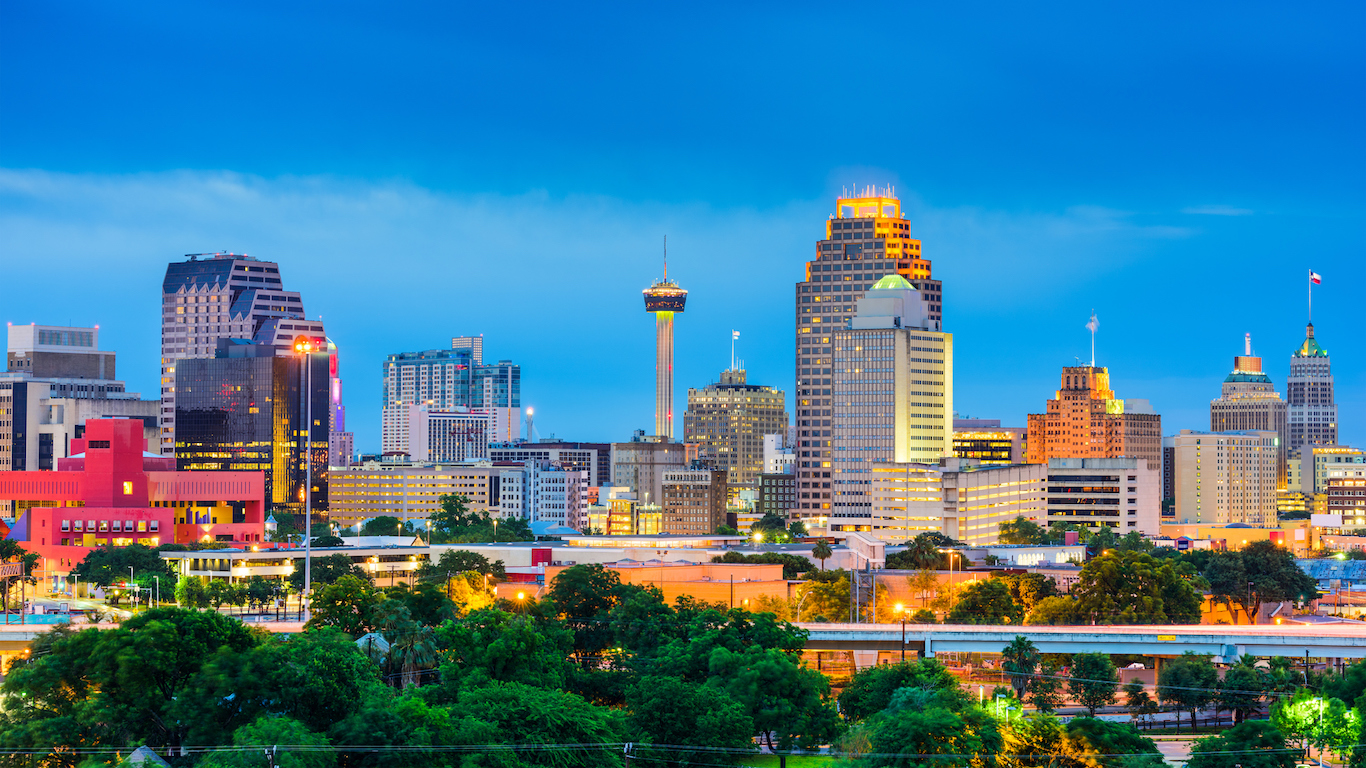
24. San Antonio-New Braunfels, TX
> Poverty rate: 14.6%
> Obesity rate: 28.5%
> Violent crimes per 100,000: 436.9
> 5-year pop. change: 10.7%
Of Gallup’s five categories of well-being — physical, financial, community, social, and purpose — residents of the San Antonio-New Braunfels metro area rank highest in sense of purpose. Nearly four of every five surveyed residents like they like what they do every day, and 72% get to use their strengths on a daily basis, each some of the highest such percentages nationwide. San Antonio residents also benefit from strong social connections. Nearly 80% of surveyed metro area residents have someone in their lives who encourages them to be healthy, a larger share than the 75% national average.

23. Des Moines-West Des Moines, IA
> Poverty rate: 10.7%
> Obesity rate: 29.8%
> Violent crimes per 100,000: 367.5
> 5-year pop. change: 8.9%
Des Moines metro area residents are less likely to report regular sadness than the typical American. Only 13.2% of those polled in the area reported feeling sad compared to some 17.5% of Americans. The relative happiness of the population may be attributable to strong personal relationships and financial security. About 80% of residents polled report that their relationship with their partner or closest friend is stronger than ever compared to 76.6% of Americans. Additionally, the Des Moines metro area is one of only 11 nationwide where over half of all survey respondents have enough money do everything they want.

22. San Diego-Carlsbad, CA
> Poverty rate: 13.8%
> Obesity rate: 20.2%
> Violent crimes per 100,000: 331.8
> 5-year pop. change: 6.3%
Home to well over 3 million people, the San Diego metro area is one of the largest in the country. It is also one of the happiest. Residents’ physical health likely plays a considerable role in overall well-being. San Diego residents are more likely to exercise and eat healthy the average American. Partially as a result, only 20.2% of area residents are obese, nearly the smallest share in the country, and 61.9% report being in near peak physical health, nearly the largest share of any U.S. metro area.
San Diego residents are also proud of their city. Nearly 72% of metro area survey respondents agree that where they lived is the perfect place for them, compared to only 63% of Americans.
[in-text-ad-2]

21. Durham-Chapel Hill, NC
> Poverty rate: 15.9%
> Obesity rate: 26.2%
> Violent crimes per 100,000: N/A
> 5-year pop. change: 8.7%
A larger share of Durham-Chapel Hill residents report having healthy, positive relationships in their lives than nearly any other metro area. More than four in five surveyed residents believe their friends and family give them positive energy, and 79.3% report having someone in their lives who encourages them to be healthy — some of the largest shares of any metro area. Such encouragement may be having a positive effect, as Durham-Chapel Hill residents are also among the healthiest of any metro area. According to Gallup’s survey, people living in Durham-Chapel Hill are more likely to maintain healthy diets and exercise regularly than the typical American.

20. Anchorage, AK
> Poverty rate: 8.7%
> Obesity rate: 27.4%
> Violent crimes per 100,000: 1,039.5
> 5-year pop. change: 4.3%
Without sufficient income, not only is it a challenge to meet basic life needs, but also regular stress is much more common. This is not a problem for Anchorage residents. The typical household earns $78,238 annually, ninth highest of U.S. metro areas. When asked, “in the last seven days have you worried about money,” fewer than 30% of respondents said yes, one of the lowest shares.
On the other hand, high well-being — financially-driven or otherwise — does not always correspond with more measurable factors of quality of life. For example, safety is a major component of life quality, but in Anchorage, over 1,000 violent crimes per 100,000 people are reported annually, one of the highest violent crime rates nationwide.
[in-text-ad]

19. Salinas, CA
> Poverty rate: 15.3%
> Obesity rate: 23.7%
> Violent crimes per 100,000: 443.2
> 5-year pop. change: 4.2%
As of December 2016, 7.3% of the Salinas labor force was unemployed, one of the highest unemployment rates compared with other U.S. metro areas. Despite the struggles of the local labor market, reported workplace well-being among Salinas residents is high. Of area adults surveyed, 82.7% say they like what they do every day, 75.4% report learning something new every day, 91.0% report using their strengths every day, and 70.6% say they have a supervisor that treats them like a partner. Each of these factors are major determinants of happiness, and in Salinas are among the top 10 compared to other metro areas.

18. Provo-Orem, UT
> Poverty rate: 12.6%
> Obesity rate: 23.3%
> Violent crimes per 100,000: 71.7
> 5-year pop. change: 10.5%
Provo-Orem residents have a higher estimation of where they will be in five years than people in any other metro area. A lack of serious financial hardship likely fuels widespread optimism in the area. The typical area household earns $65,092 a year, far more than the $55,775 national median income. Likely related, only 8.5% of survey respondents report struggling to afford food, nearly the smallest share of any metro area in the country.
Provo-Orem residents are also generally happy with their communities. The metro area is one of only 11 in the United States where more than three-quarters of survey respondents said they are proud of the area they live in.

17. Santa Rosa, CA
> Poverty rate: 11.1%
> Obesity rate: 21.6%
> Violent crimes per 100,000: 376.7
> 5-year pop. change: 3.6%
Santa Rosa residents are more likely to take good care of their personal health than the average American. About 72% of area residents surveyed report eating healthy throughout the day, nearly the highest share of any metro area in the country. Additionally, only 11.6% of residents are smokers, well below the 17.0% share of American adults.
In addition to physical health, overall well-being in Santa Rosa is likely bolstered by a strong sense of community. Some 65.1% of area residents surveyed said they could not imagine a better community than their own, the third largest share of any metro area.
[in-text-ad-2]
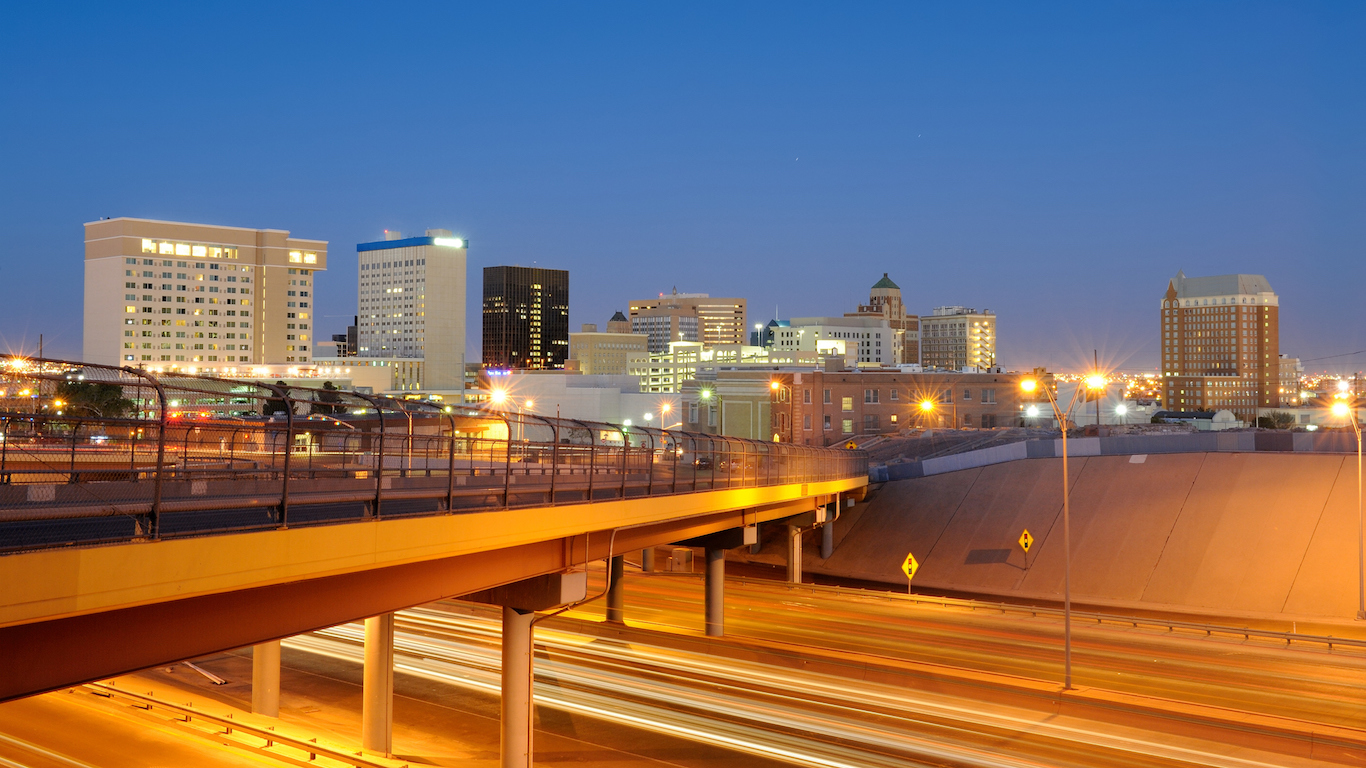
16. El Paso, TX
> Poverty rate: 20.1%
> Obesity rate: 26.6%
> Violent crimes per 100,000: 354.3
> 5-year pop. change: 3.9%
Having a sense of purpose and direction can have a significant bearing on an individual’s well-being, and a relatively large share of El Paso residents have a well developed sense of purpose. Some 68.2% of survey respondents in the metro area say they have a role model in their lives that makes them enthusiastic about the future, the eighth largest share in country. People living in the area also tend to be future oriented as nearly 60% of respondents achieved a majority of goals they set over the preceding year, a larger share than in all but 10 other U.S. metro areas.
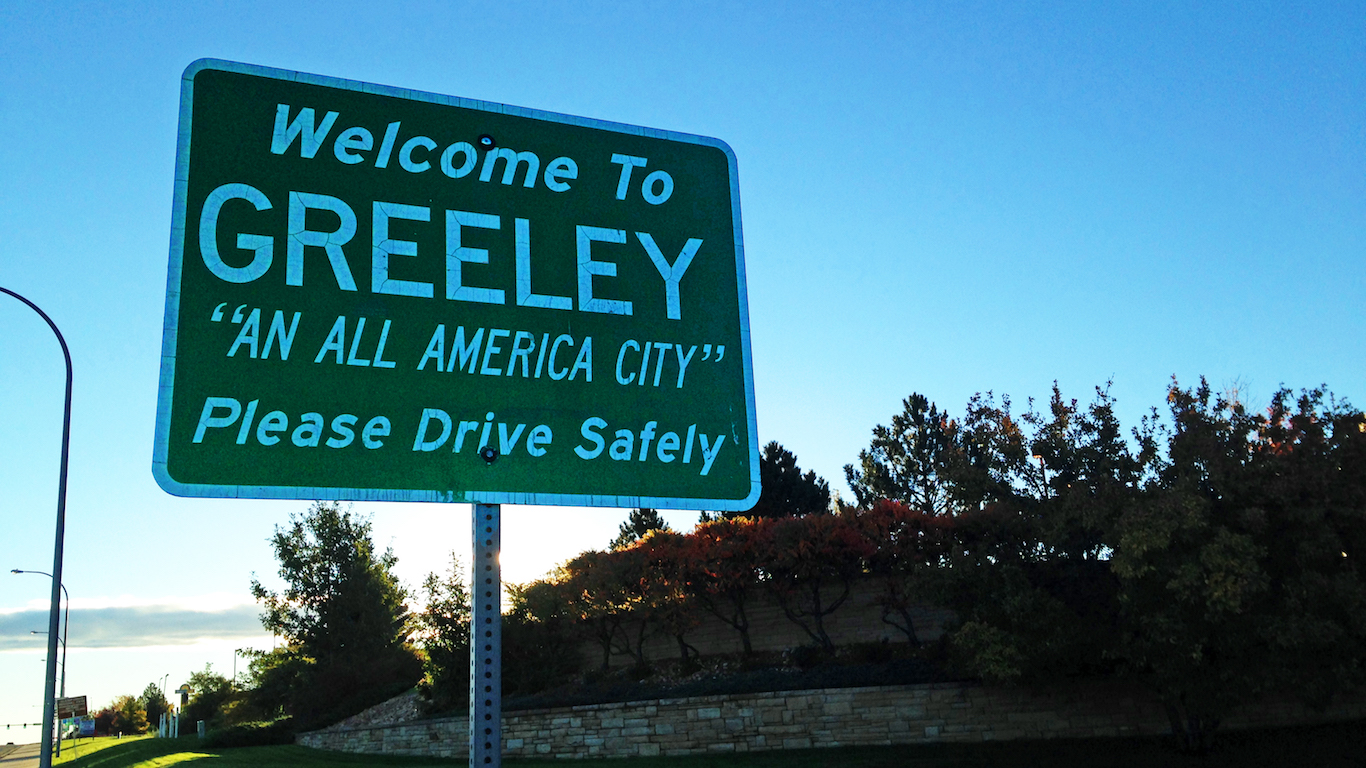
15. Greeley, CO
> Poverty rate: 11.3%
> Obesity rate: 25.5%
> Violent crimes per 100,000: 270.6
> 5-year pop. change: 12.2%
Greeley is one of several metropolitan areas situated along Interstate 25 in the Front Range region of Colorado where residents are among the happiest in the country. Greeley residents report having a strong sense of purpose. Approximately 82% of surveyed residents enjoy what they do every day, and 76% believe they are able to use their strengths to the best of their ability in daily life, compared to 77% and 69% of Americans, respectively. Greeley’s healthy job market may be one reason why so many residents find fulfillment in their lives and careers. Just 2.8% of the area’s workforce is unemployed, nearly the smallest share of any city.
[in-text-ad]

14. McAllen-Edinburg-Mission, TX
> Poverty rate: 31.5%
> Obesity rate: 36.7%
> Violent crimes per 100,000: 298.1
> 5-year pop. change: 8.1%
A relatively large 31.5% share of McAllen-Edinburg-Mission metro area residents live in poverty. Despite financial challenges, metro area residents’ well-being benefits from a strong sense of purpose, community, and social life. As a result, the city’s population is one of the happiest in the country and the McAllen metro area ranked second in the country in terms of area residents’ perception of their own success.
Located on the U.S.-Mexico border, McAllen’s population has expanded 8.1% in the past five years, more than twice the national population growth rate. While McAllen’s 31.5% poverty rate is third highest in the country, many new residents may be immigrating to the United States with a fresh optimism that partially accounts for the city’s high sense of well-being.

13. Prescott, AZ
> Poverty rate: 15.1%
> Obesity rate: 24.7%
> Violent crimes per 100,000: 294.0
> 5-year pop. change: 5.3%
Prescott residents report a higher degree of satisfaction with their community than most metropolitan areas. Approximately 80% of those surveyed believe their current house or apartment is the ideal residence for them and their family, and 85% report a constant feeling of safety, each among the largest such shares in the country. The area’s violent crime rate of 294 incidents per 100,000 residents is indeed far lower than the national rate of 387 violent crimes per 100,000 Americans. Strong community ties may be facilitated by the large number of area residents living in retirement communities. About 29% of metro residents are 65 and older, almost twice the national share.
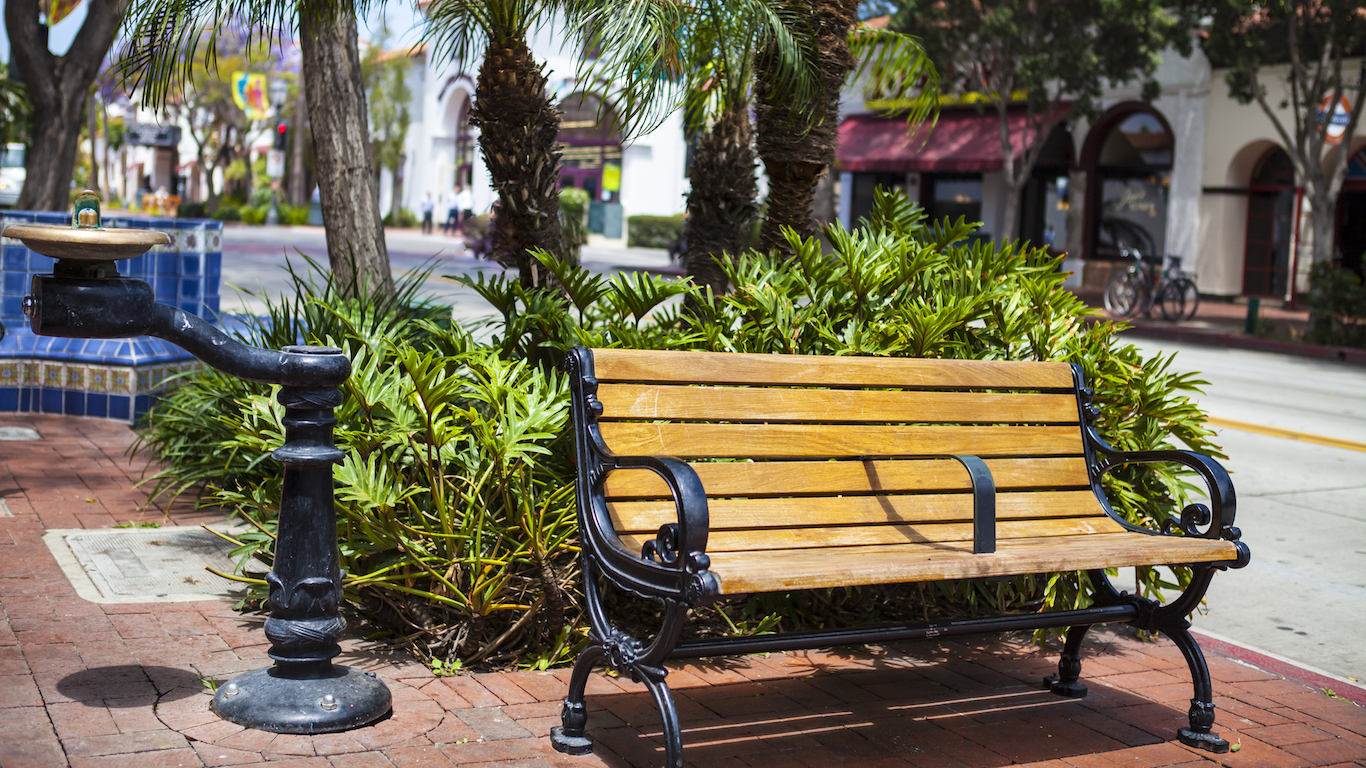
12. Santa Maria-Santa Barbara, CA
> Poverty rate: 15.7%
> Obesity rate: 19.0%
> Violent crimes per 100,000: 322.2
> 5-year pop. change: 4.8%
Physical health and strong social connections can have a significant bearing on individual well-being, and Santa Maria-Santa Barbara residents tend to take good care of their health and relationships. Only 12.4% of metro area adults smoke, one of the smaller shares among metropolitan areas. Also, the Santa Maria area is one of only 16 nationwide where over 60% of surveyed residents exercise regularly. Physical health is bolstered by personal relationships in Santa Maria as 80.3% of respondents in the area say they receive encouragement to be healthy from someone in their life. The metro area is also one of less than two dozen nationwide where over 80% of those polled report their relationship with a close friend or partner is stronger than ever.
[in-text-ad-2]
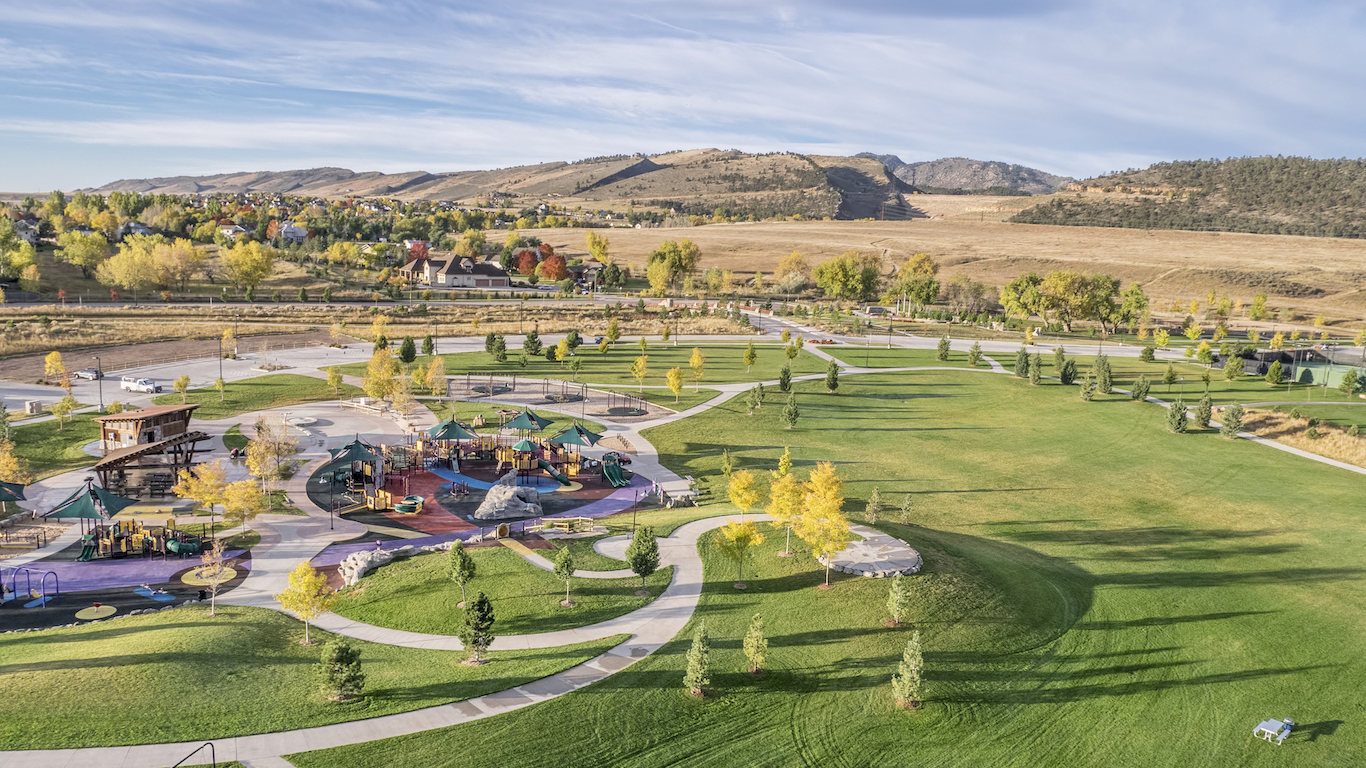
11. Fort Collins, CO
> Poverty rate: 12.7%
> Obesity rate: 18.9%
> Violent crimes per 100,000: 199.1
> 5-year pop. change: 11.0%
In the Fort Collins metro area, 78.7% of surveyed residents state they are proud of their community, 76.6% believe their city is the perfect place for them, and 87.7% report always feeling safe — correspondingly the third, fourth, and fifth largest shares nationwide. A strong sense of security among Fort Collins residents is likely justified as the metro area’s violent crime rate of 199 incidents per 100,000 residents is far less than the national rate of 387 violent crimes per 100,000 Americans. Fort Collins is one of several metro areas in Colorado’s Front Range region to rank among the happiest in the country.

10. Boulder, CO
> Poverty rate: 12.9%
> Obesity rate: 13.3%
> Violent crimes per 100,000: N/A
> 5-year pop. change: 7.9%
One of the healthiest cities in the country, Boulder residents report a greater sense of physical well-being than any metro area other than Barnstable Town, Massachusetts. A nation-leading 69.6% of surveyed Boulder residents exercise regularly. Only 13.3% of metro area adults are obese, the lowest share of any metro area nationwide. With opportunities for running and walking along Boulder Creek Path, rock climbing in Eldorado Canyon State Park, or other activities in the 60-plus public parks throughout the area, roughly 98% of residents have access to locations for physical activity.
A college education can improve an individual’s sense of control over their life and enhance their overall well-being. In Boulder, 60.6% of adults have at least a bachelor’s degree, the largest share of any U.S. metro areas.
[in-text-ad]

9. Hilton Head Island-Bluffton-Beaufort, SC
> Poverty rate: 14.3%
> Obesity rate: 24.6%
> Violent crimes per 100,000: 349.4
> 5-year pop. change: 10.4%
With miles of beaches, hundreds of tennis courts, and two dozen golf courses as well as venues for kayaking, biking, and hiking on Hilton Head Island alone, the Hilton Head Island-Bluffton-Beaufort metro area is a popular vacation destination for many. The people who call the area home are also pleased with their communities. Gallup found that 64.1% of area residents cannot imagine a better community than their own, the sixth largest share of any metro area, and 74% are proud of their community, 10 percentage points higher than the comparable national figure.
Hilton Head residents also take good care of themselves. Some 72% of survey respondents eat healthy throughout the day, and 61.4% exercise regularly, each the seventh highest share of any U.S. metro area.
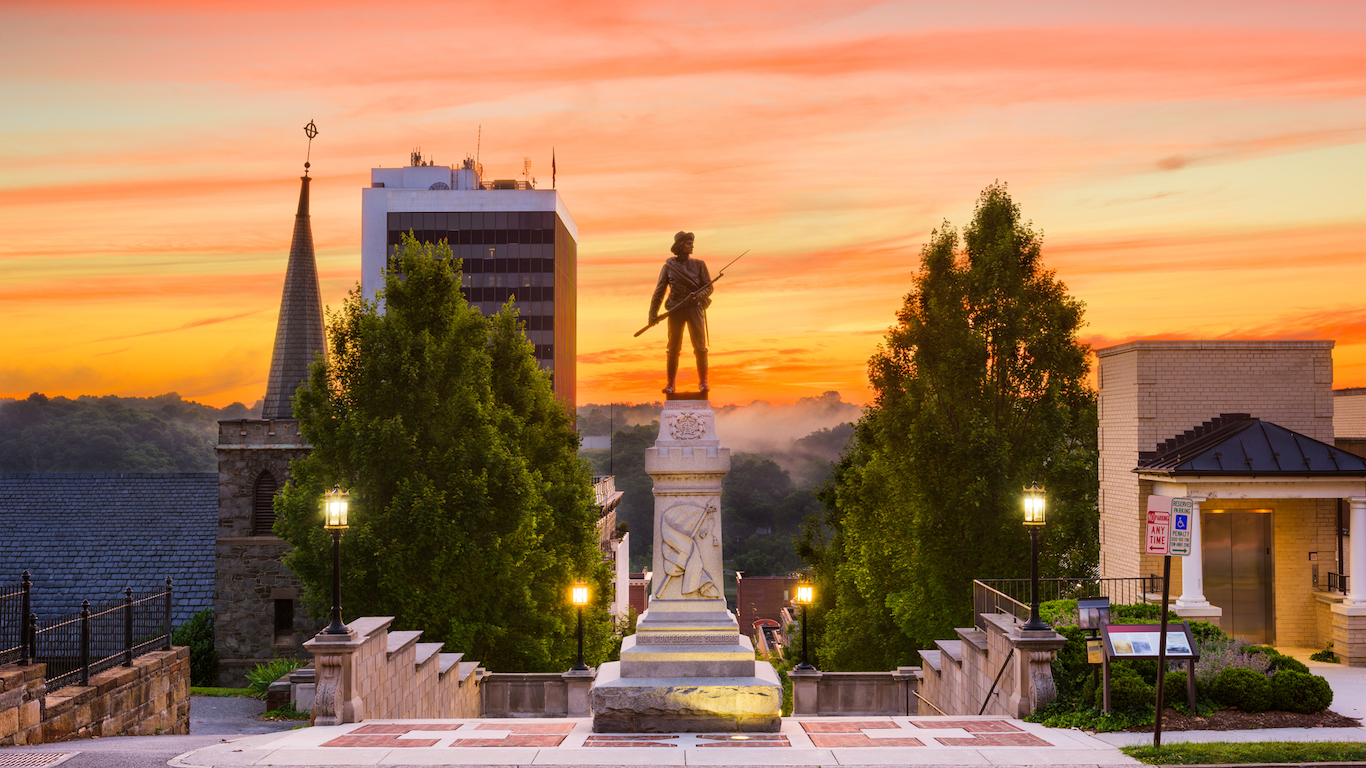
8. Lynchburg, VA
> Poverty rate: 14.8%
> Obesity rate: 30.8%
> Violent crimes per 100,000: 180.4
> 5-year pop. change: 2.7%
Some 95.3% of survey respondents in the Lynchburg metro area reported experiencing happiness regularly, the largest share of any area surveyed. Personal happiness is closely tied to environment, and Lynchburg residents appear to be happy with their communities. Some 77.5% of those surveyed agree that their city is a perfect place for them, and nearly 85% report feeling safe and secure, the third and 18th largest shares of any metro area, respectively.
Overall well-being in the Lynchburg area is also boosted by healthy personal relationships. The area is one of only three in the country where more than 70% of respondents report having a role model that makes them enthusiastic about the future.

7. San Luis Obispo-Paso Robles-Arroyo Grande, CA
> Poverty rate: 14.9%
> Obesity rate: 21.8%
> Violent crimes per 100,000: 403.3
> 5-year pop. change: 4.3%
Like many other metro areas in California with high self-reported overall well-being, people in the San Luis Obispo metro area keep themselves in relatively good physical health. Some 67% of area residents surveyed exercise regularly, and 72% report eating healthy throughout the day, the third and eighth largest shares of any U.S. metro area.
People in the area are also very happy with their communities. Of all residents surveyed, 66% agree that they could not imagine a better community than their own, the largest share of any metro area in the country.
[in-text-ad-2]
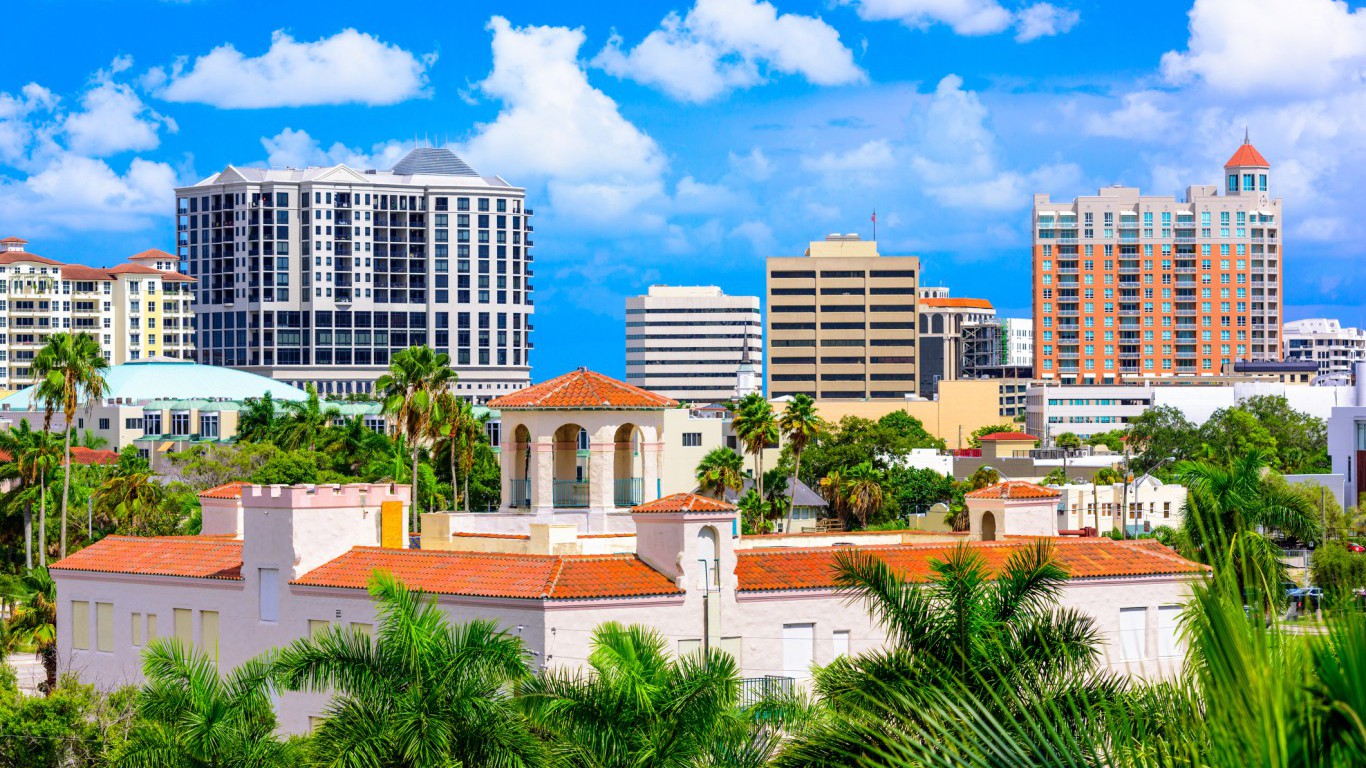
6. North Port-Sarasota-Bradenton, FL
> Poverty rate: 11.8%
> Obesity rate: 22.4%
> Violent crimes per 100,000: 416.6
> 5-year pop. change: 9.3%
Located along Florida’s Gulf Coast, North Port-Sarasota-Bradenton is one of several oceanfront U.S. metro areas to rank highest in terms of residents’ overall well-being. Just over 64% of residents surveyed agree their community is the best they can imagine, nearly the largest share in the country and far higher than the 51.6% share of respondents nationwide.
Financial pressures detract less from overall well-being in the area compared to most parts of the country. According to the Gallup survey, 57.8% of area residents have not worried about money in the past seven days, the largest share of any U.S. metro area.

5. Charlottesville, VA
> Poverty rate: 13.1%
> Obesity rate: 25.8%
> Violent crimes per 100,000: 164.6
> 5-year pop. change: 4.8%
Residents of the Charlottesville metro area report a higher sense of social well-being than nearly any other city in the country. Roughly 82% of residents say their relationship with either their spouse, partner, or closest friend is as strong as ever, and 83% report having someone in their life who encourages them to be healthy, each the fourth largest share of any major metro area. In addition to strong social connections, Charlottesville residents’ well-being is also buttressed by their physical health. Some 63% of respondents report near-perfect physical health, a much larger share than the 57% national average.
[in-text-ad]

4. Urban Honolulu, HI
> Poverty rate: 9.2%
> Obesity rate: 21.9%
> Violent crimes per 100,000: 243.9
> 5-year pop. change: 4.4%
Well-being is often simply a question of whether people are happy, smile, or laugh on a regular basis. In Honolulu, 92.2% of adults say they experience happiness, 89.8% say they experience enjoyment, and 84.1% report smiling and laughing frequently — each among the highest such percentages compared with other U.S. metro areas surveyed. Financial security and healthy behaviors among the population help explain the high reported well-being. Even with near-nation-leading cost of living, the typical Honolulu household is extremely affluent, with annual income of $77,273. The metro area’s adult smoking rate of 12.9%, and adult obesity rate of 21.9%, are also each among the lowest such percentages.

3. Santa Cruz-Watsonville, CA
> Poverty rate: 16.1%
> Obesity rate: 20.6%
> Violent crimes per 100,000: 427.8
> 5-year pop. change: 4.1%
Residents of the Santa Cruz-Watsonville metro area are among the happiest in the country. Santa Cruz is the only metro area in which more than four in five respondents report that the city they live in is the perfect place for them. While goods and services cost 22 cents more on the dollar in Santa Cruz than they do nationwide, residents exhibit a high degree of financial well-being. The area’s $65,139 median annual household income is over $9,000 more than nationwide median income, and 51% of surveyed residents believe they have enough money to do everything they want — the eighth largest share of any major city.
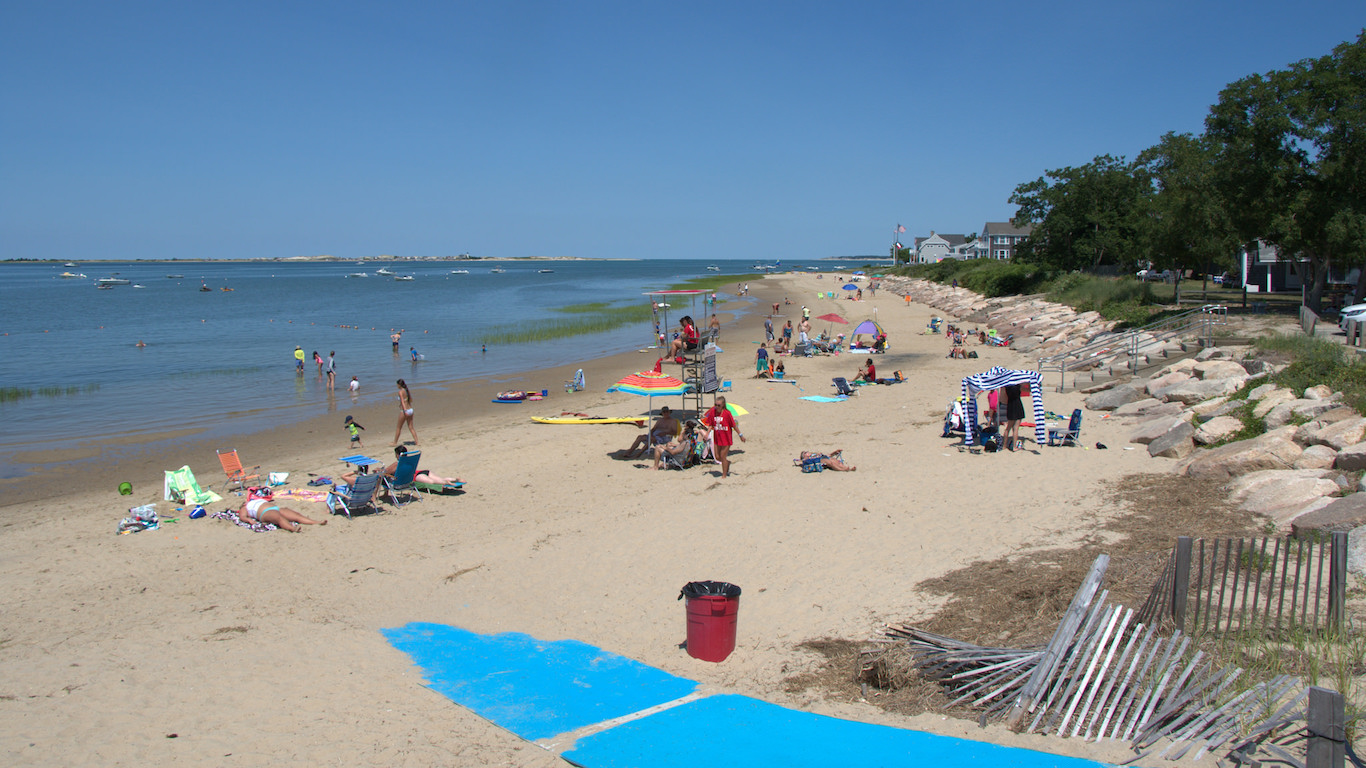
2. Barnstable Town, MA
> Poverty rate: 6.6%
> Obesity rate: 19.7%
> Violent crimes per 100,000: 518.7
> 5-year pop. change: -0.7%
The Barnstable Town metro area, which comprises the Cape Cod area, is one of only a handful of metro areas where a majority residents report having enough money to do everything they want. Just 6.6% of area residents live in poverty, one of the lowest rates nationwide and less than half the national poverty rate of 14.7%.
Well-educated populations tend to be more financially stable, and report greater well-being. In the Cape Cod area, 40.1% of adults have at least a bachelor’s degree, one of the highest educational attainment rates of any metro area. Affluent, college-educated people often have an easier time reaching their personal goals. When asked, “in the past 12 months, have you reached most of your goals,” over 60% of respondents said yes, the sixth highest such percentage of all metro areas reviewed.
[in-text-ad-2]

1. Naples-Immokalee-Marco Island, FL
> Poverty rate: 14.2%
> Obesity rate: 18.8%
> Violent crimes per 100,000: 286.7
> 5-year pop. change: 10.7%
The Naples, Florida region is the nation’s happiest metro area. Affluence and strong social ties — common in older populations in large retirement communities — have contributed to the nation-leading well-being across Naples, Immokalee, and Marco Island. The typical household earns $62,126 annually, well above the national median of $55,775 a year. Residents were also significantly more likely than people nationwide to report having enough money to meet their everyday desires.
Community improvement projects have flourished across Southwest Florida in recent years. For example, since 2015, the metropolitan area has added roundabouts, sidewalks, and bike lanes to improve pedestrian and bike travel. About 91% of residents have access to a safe place to exercise, one of the higher shares in the country. Perhaps partially as a result, more than two-thirds of survey respondents in the area say their physical health is near perfect, the highest proportion of any metro area reviewed.
The Most Miserable Cities in America.

25. Memphis, TN-MS-AR
> Poverty rate: 18.4%
> Obesity rate: 34.4%
> Violent crimes per 100,000: 1,038.0
> 5-year pop. change: 1.3%
Of Gallup’s five elements of well-being — physical, financial, social, community, and purpose — residents of the Memphis metro area rank the lowest in their sense of community. One reason for the lack of community spirit may be the 1,038 violent crimes per 100,000 residents reported annually, more than 2.5 times the national rate of 387 violent crimes per 100,000 Americans. As many as 19% of Memphis residents surveyed say they do not feel safe or secure, the fourth largest share nationwide. Just 52% of survey respondents believe Memphis is the perfect city for them, and only 56% claim they are proud of their community, nearly the lowest shares of any metro area.
[in-text-ad]

24. Stockton-Lodi, CA
> Poverty rate: 17.4%
> Obesity rate: 29.4%
> Violent crimes per 100,000: 797.1
> 5-year pop. change: 5.6%
Only 50.6% of survey respondents in the Stockton-Lodi area are proud of their community, the second smallest share of any metro area in the country. A lack of community pride may be tied to the prevalence of violent crime. There were 797 violent crimes for every 100,000 metro area residents in 2015, the ninth highest violent crime rate of any metro area in the country. Likely because of the high crime rate, about one in every five area residents do not feel safe in their community, the largest share of any MSA in the Gallup survey.
High crime areas often also have lagging economies, and Stockton-Lodi’s 7.7% unemployment rate is higher than in all but 14 other U.S. metros.

23. Oklahoma City, OK
> Poverty rate: 14.5%
> Obesity rate: 30.8%
> Violent crimes per 100,000: 462.0
> 5-year pop. change: 8.0%
Oklahoma City’s population grew by 8% between 2010 and 2015, twice the national population growth rate over that period. The growth reflects favorable economic conditions — the metro area’s unemployment rate of 4.2% is slightly below the national rate. Yet, residents of Oklahoma City report relatively low overall well-being. Financial constraints are likely contributing factors. While the area’s poverty rate of 14.5% is in line with the national rate, 17.1% of surveyed residents say they do not have enough money to buy food, and 19.3% say they do not have enough money for health care, each higher than the corresponding national percentages.

22. Roanoke, VA
> Poverty rate: 13.2%
> Obesity rate: 28.9%
> Violent crimes per 100,000: 213.9
> 5-year pop. change: 1.9%
In no metropolitan area did well-being decline to a greater degree between 2015 and 2016 than Roanoke, Virginia. Today, 14% of residents surveyed in the Roanoke area say their friends and family do not give them positive energy on a daily basis, and 16% state they do not have someone in their lives who encourages them to be healthy — each the fourth largest such share of any metro area. A strong social support network can be a prerequisite for a healthy lifestyle, and Roanoke’s population is relatively unhealthy. Roughly 40% of surveyed residents have had high blood pressure in their lifetime, and 29% have had high cholesterol, each among the highest shares in the country.
[in-text-ad-2]
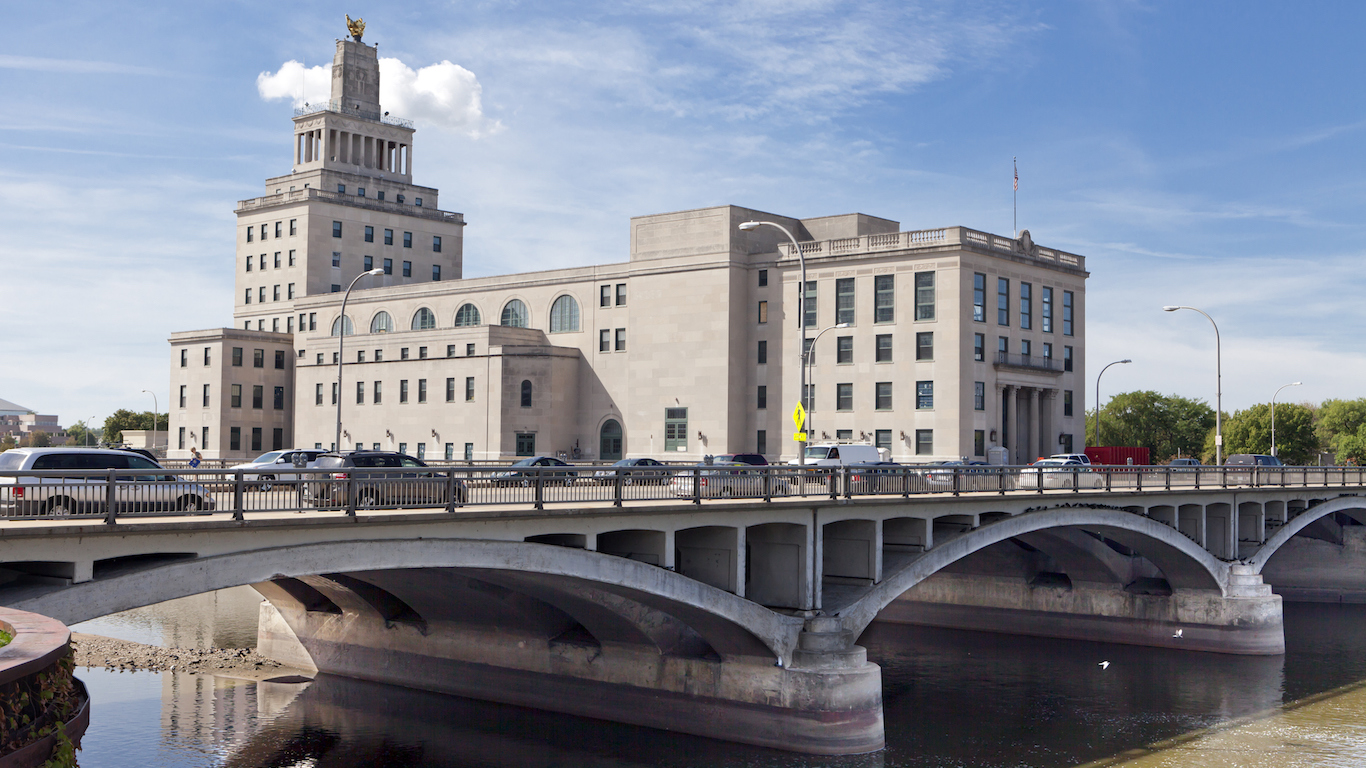
21. Cedar Rapids, IA
> Poverty rate: 11.1%
> Obesity rate: 30.5%
> Violent crimes per 100,000: 189.5
> 5-year pop. change: 3.0%
Cedar Rapids residents are more likely to lack a strong sense of purpose than most Americans. Only 54.7% of survey respondents in the metro area say they have a role model in their lives who makes them enthusiastic about the future, nearly the smallest share of any area surveyed. In addition, a relatively large share of Cedar Rapids residents do not take especially good care of themselves. Only 45.6% of survey respondents exercise regularly, the third smallest share of any U.S. metro area. Partially as a result, the area’s 30.5% obesity rate is above the 27.0% corresponding national rate.

20. Gulfport-Biloxi-Pascagoula, MS
> Poverty rate: 20.0%
> Obesity rate: 32.0%
> Violent crimes per 100,000: 233.3
> 5-year pop. change: 4.8%
Residents of Gulfport-Biloxi-Pascagoula have some of the worst physical well-being of any metropolitan area. Residents are among the most likely in the nation to have their daily scheduled disrupted because of poor health. An estimated 30.2% of area adults lead sedentary lives, and 32.0% are obese, much larger shares than the national 23% inactivity rate and 27% obesity rate. Gulfport’s median household income of $44,328 a year is roughly $11,500 less than the median income nationwide. Low income may prevent city residents from leading active, healthy lives. As many as 23% of surveyed Gulfport residents claim they do not have enough money to buy food, nearly the largest share nationwide.
[in-text-ad]

19. Tulsa, OK
> Poverty rate: 15.4%
> Obesity rate: 31.8%
> Violent crimes per 100,000: 500.8
> 5-year pop. change: 4.4%
Poor social cohesion and unfulfilling relationships push Tulsa, Oklahoma down on Gallup’s well-being index. Relationships with friends and family often need to be nurtured in order to be mutually beneficial, and more than one in three Tulsa metro area residents surveyed do not make time for regular trips or vacations with friends and family, one of the larger shares of any metro area surveyed. Additionally, only 71.2% of residents surveyed say that they have someone in their lives encouraging them to be healthy, one of the smallest such shares of any metro area — and many area residents would benefit from healthier habits. People in Tulsa are more likely to smoke and less likely to exercise than the average American.

18. Bakersfield, CA
> Poverty rate: 21.9%
> Obesity rate: 28.5%
> Violent crimes per 100,000: 556.3
> 5-year pop. change: 4.8%
One component of happiness that appears to be missing from the lives of many Bakersfield residents is a strong social support network. Just 73.5% of surveyed Bakersfield residents say their relationship with their spouse, partner, or closest friend is as strong as it has ever been, one of the smallest shares. Meanwhile, 39% state they do not make time for regular trips or vacations with friends and family, the second-largest shares nationwide. Lack of social support likely hinders a sense of community in Bakersfield. Some 28% of residents do not believe Bakersfield is the right city for them, and 68% do not feel safe. One reason may be the high violent crime rate, which at 556 incidents per 100,000 residents is well among the nationwide rate.
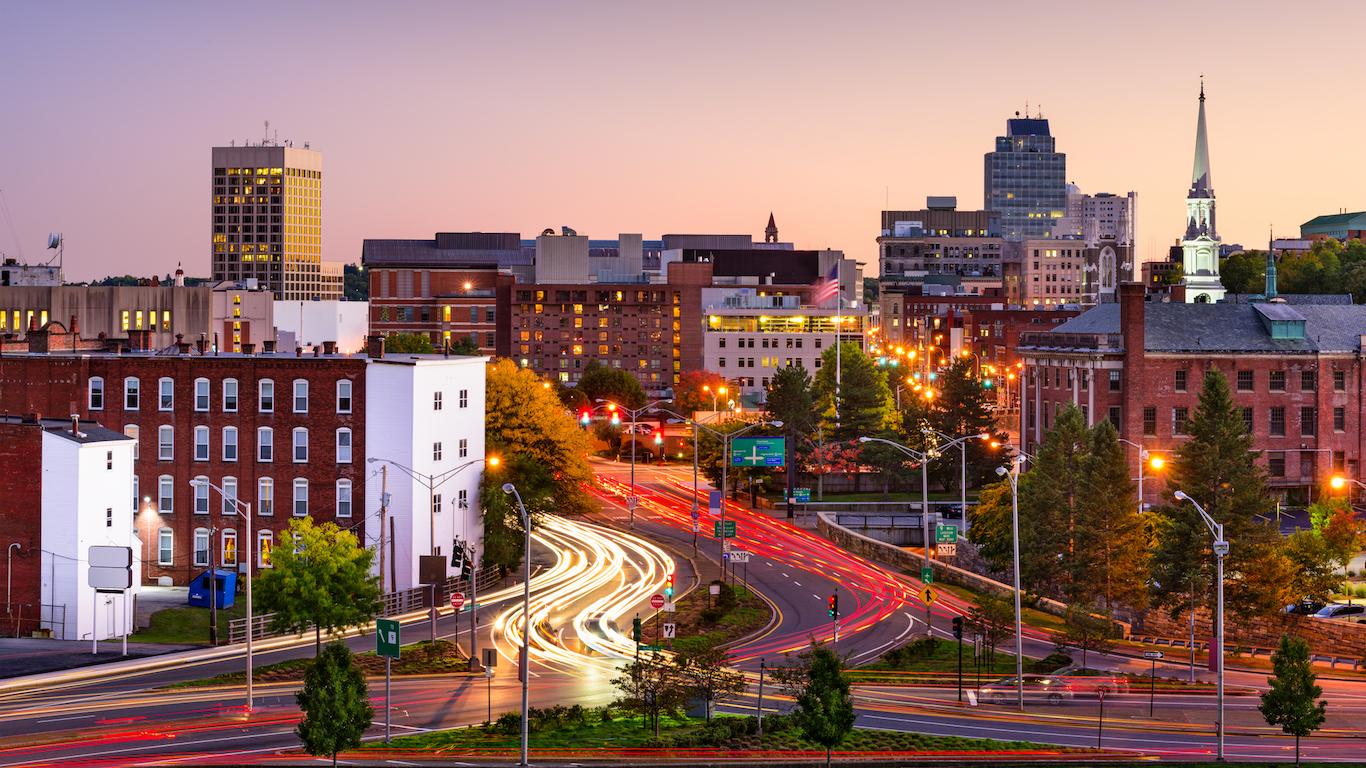
17. Worcester, MA-CT
> Poverty rate: 11.9%
> Obesity rate: 26.5%
> Violent crimes per 100,000: 434.8
> 5-year pop. change: 1.8%
Residents in only a handful of cities report a lesser sense of purpose than those in the Worcester metro area. While just 3.3% of the Worcester workforce is unemployed, and 38.0% of residents have a bachelor’s degree — compared to 4.7% and 30.6%, respectively, nationwide — the area’s strong economy may not be providing fulfilling occupations that can provide city residents with a strong sense of purpose. Approximately 11% of surveyed residents do not like what they do every day, and 18% do not learn something new on a daily basis, each among the largest shares nationwide.
[in-text-ad-2]

16. Little Rock-North Little Rock-Conway, AR
> Poverty rate: 17.0%
> Obesity rate: 31.5%
> Violent crimes per 100,000: 724.7
> 5-year pop. change: 4.2%
Nearly 16% of survey respondents in the Little Rock metro area have not experienced happiness regularly over the last two years — the fourth highest share of any metro area in the country. Many area residents depend on substances to control their mood. More than one in four Gallup survey respondents in the metro area report using drugs or medication to help them relax almost every day, one of the highest such shares in the country.
Problems such as these may be tied to unfulfilling social connections. Nearly 13% of survey respondents in Little Rock do not receive positive energy from friends and family on a daily basis, a higher share than in all but a handful of other U.S. metro areas.
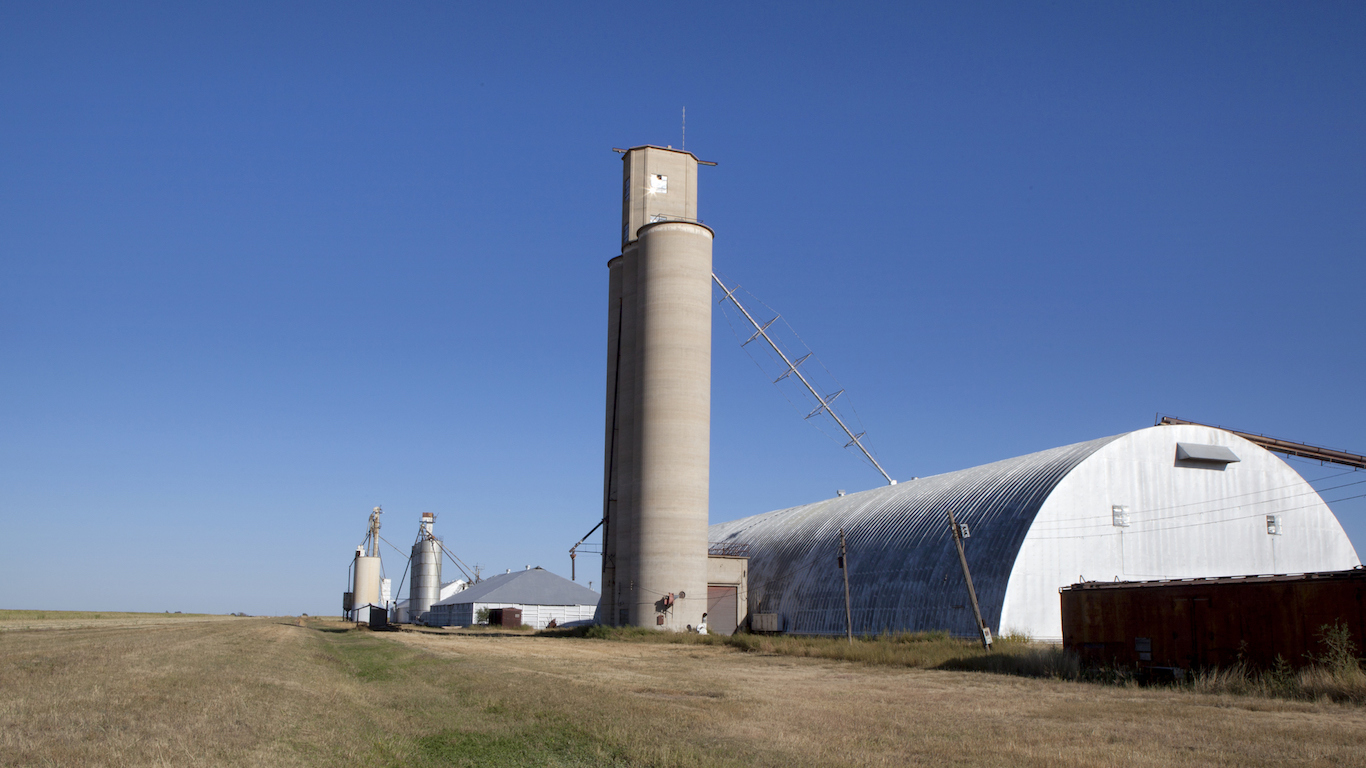
15. Lubbock, TX
> Poverty rate: 20.7%
> Obesity rate: 28.2%
> Violent crimes per 100,000: 825.4
> 5-year pop. change: 6.5%
With 825 violent crimes in 2015 for every 100,000 residents, Lubbock, Texas is one of the most dangerous metro areas in the country. Crime in the area is likely detracting from residents’ overall well-being. A smaller than typical 73.4% of survey respondents in the area say that they feel safe and secure in their community, and a larger than typical 17.1% of respondents are not proud of their community.
Poor economic conditions also likely detract from personal well-being in the Lubbock metro area. More than one in five area residents live in poverty compared to 14.7% of all Americans, and 42.3% of survey respondents in Lubbock have worried about money in the last week, the third largest share of any metro area.
[in-text-ad]

14. Olympia-Tumwater, WA
> Poverty rate: 12.7%
> Obesity rate: 28.6%
> Violent crimes per 100,000: 242.5
> 5-year pop. change: 6.5%
Residents of the Olympia-Tumwater metro area report a lower sense of purpose than nearly any other metro area surveyed by Gallup. Just 73% of surveyed residents claim to like what they do every day, and less than half believe their supervisor at work treats them like a partner — some of the smallest shares nationwide.
Just 17.3% of Olympia’s adults have a bachelor’s degree, one of the lower shares among U.S. metro areas. The area’s low educational attainment rate may have led to high job dissatisfaction in the area, as those without a college degree often have less choice in their profession, and tend to be paid less.
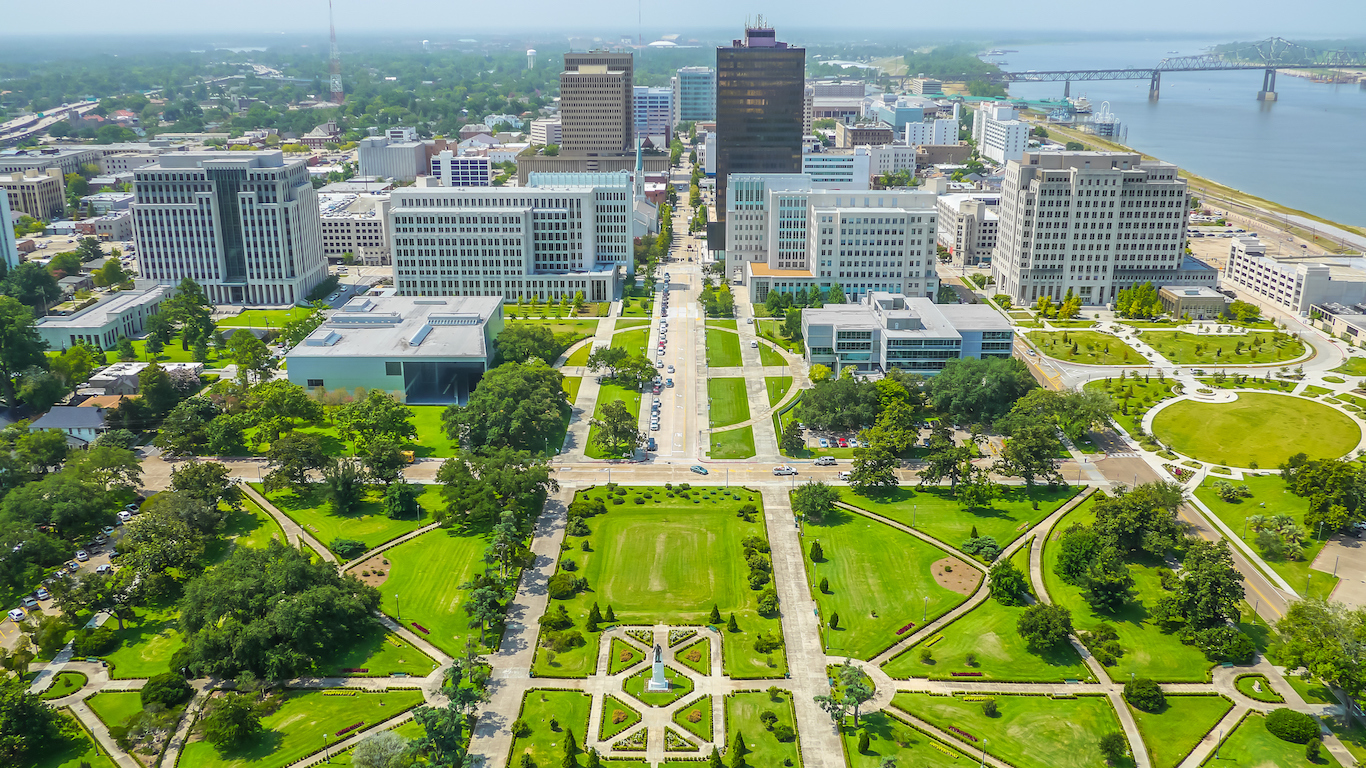
13. Baton Rouge, LA
> Poverty rate: 16.2%
> Obesity rate: 33.9%
> Violent crimes per 100,000: 478.9
> 5-year pop. change: 3.3%
It is harder for people without stable and comfortable housing to maintain a high quality of life and well-being. Fewer than two-thirds of people in Baton Rouge say the house or apartment they live in is ideal for their family, the lowest such proportion nationwide. Feeling safe and secure is also a key component of well-being, as well as a factor in feeling satisfied with a particular area. But in Baton Rouge, just 67.3% of survey respondents say they feel safe and secure, a lower percentage than in the vast majority of areas reviewed. The metro area’s violent crime rate of 478.9 incidents per 100,000 people annually is also well above the national violent crime rate.

12. Rockford, IL
> Poverty rate: 14.3%
> Obesity rate: 31.9%
> Violent crimes per 100,000: 818.8
> 5-year pop. change: -2.5%
Like in a number of other low-well being metro areas, Rockford’s population is shrinking. The population declined by 2.5% between 2010 and 2015, while populations grew nationwide and in most metro areas. Just 72.9% of surveyed area residents are satisfied with the place in which they live, much lower than the comparable national share of 85.0% and one of the lowest percentages of areas reviewed. The population decline in Rockford can likely be partially attributed to weak economic conditions, which in turn help account for the low reported well-being among area residents. Like many Midwest cities, Rockford’s economy declined considerably since its days as an industrial center of U.S. manufacturing. In December, the metro area’s unemployment rate of 6.4% was among the higher rates in the country.
[in-text-ad-2]

11. Toledo, OH
> Poverty rate: 17.2%
> Obesity rate: 32.0%
> Violent crimes per 100,000: 583.6
> 5-year pop. change: -0.7%
Toledo is one of three metro areas in Ohio where residents report relatively low overall well-being. Physical health is a crucial component of individual well-being, and many in Toledo are not taking especially good care of themselves. A larger than typical 19.6% share of area adults identify as smokers, and only 46.5% of survey respondents exercise regularly, nearly the smallest share of any U.S. metro area.
Unhealthy habits likely detract from both mental and physical health. Some 32% of metro area adults are obese, compared to 27% of all U.S. adults, and 21.3% of Gallup survey respondents in Toledo struggle with depression, higher than the 17.8% national share.
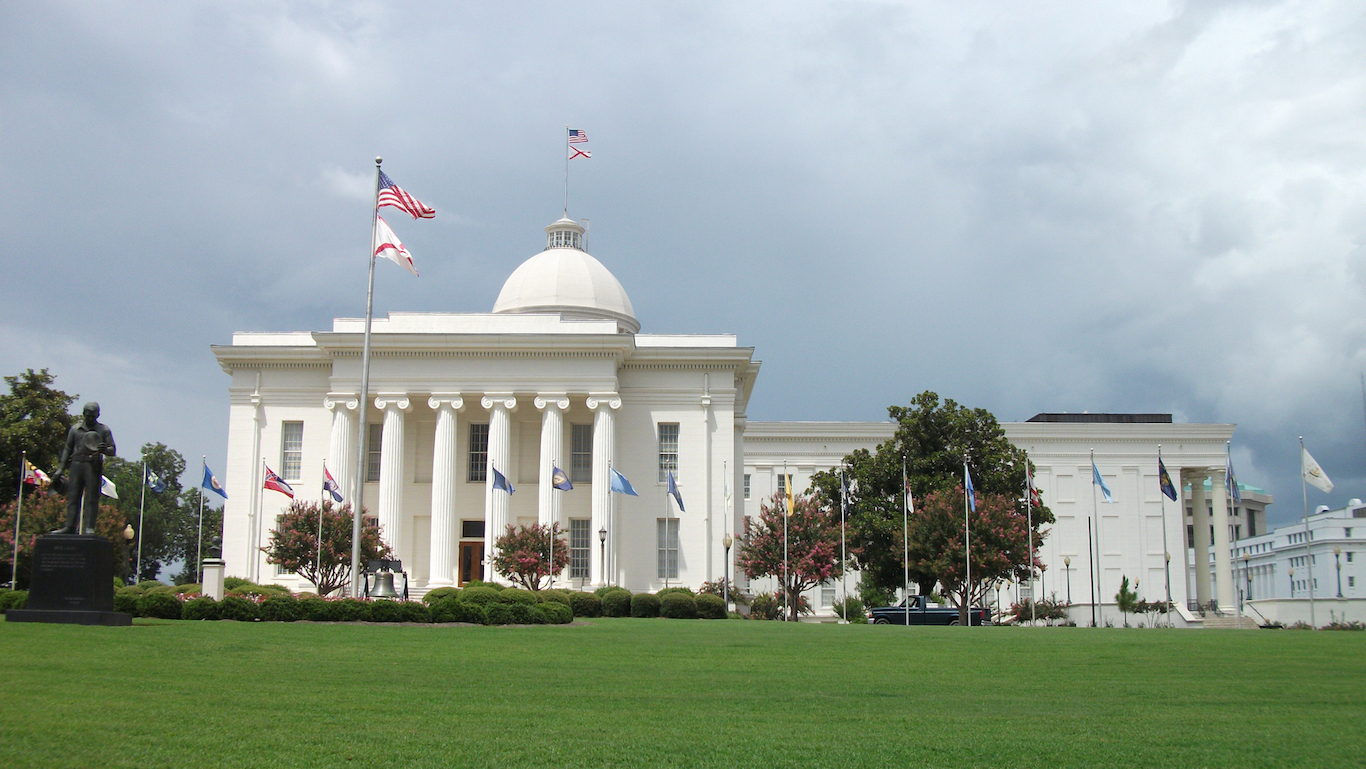
10. Montgomery, AL
> Poverty rate: 19.6%
> Obesity rate: 32.9%
> Violent crimes per 100,000: 400.7
> 5-year pop. change: -0.4%
Low incomes often cause unhealthy levels of stress as they can prevent families from meeting basic needs. Close to 40% of Montgomery survey respondents said they worried about money in the last seven days, the 15th highest share out of almost 200 metro areas. With such financial insecurity, 22.2% of respondents said they did not have enough money for food, and 21.4% said they did not have enough money for health care, each well above the respective national percentages.
Nearly 20% of areas residents live in poverty, one of the highest poverty rates nationwide. Poverty can contribute to and is common among relatively unhealthy populations. In Montgomery, 32.9% of adults are obese, compared to a national rate of 27.0%.
[in-text-ad]
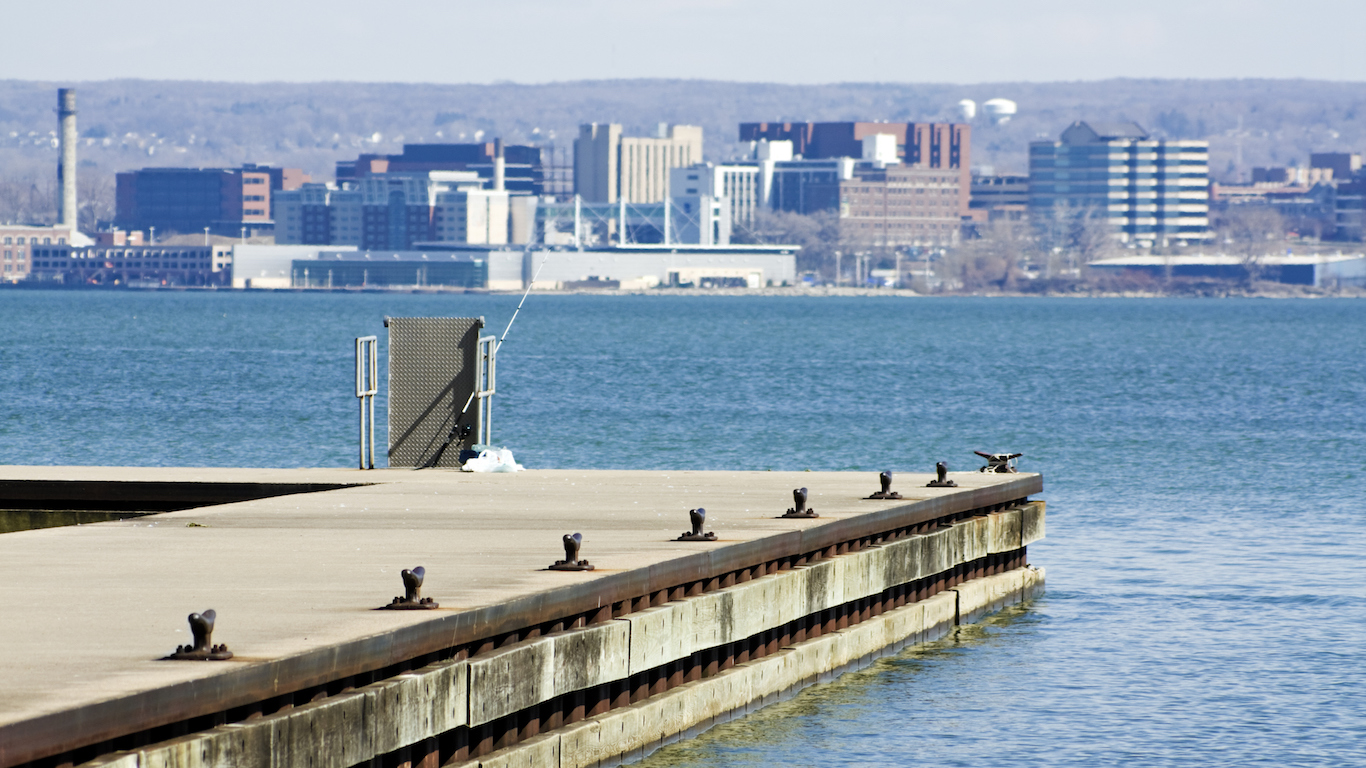
9. Erie, PA
> Poverty rate: 17.5%
> Obesity rate: 30.7%
> Violent crimes per 100,000: 234.4
> 5-year pop. change: -1.0%
Some unhealthy habits are relatively common in Erie, Pennsylvania. Just over 21.5% of area adults are smokers, one of the higher shares of all U.S. metro areas. Unhealthy habits do not stop with tobacco use. Erie residents are also far more likely to depend on substances to control their mood than the typical American. According to Gallup, 28.8% of survey respondents in Erie take medication or drugs to help them relax almost every day, the highest share of any U.S. metro area and well above the 18.9% share of Americans. Many area residents who are dependent on drugs are likely abusing prescription pain medication. Erie is one of the hardest hit areas in one of the states suffering the most from the opioid addiction epidemic.
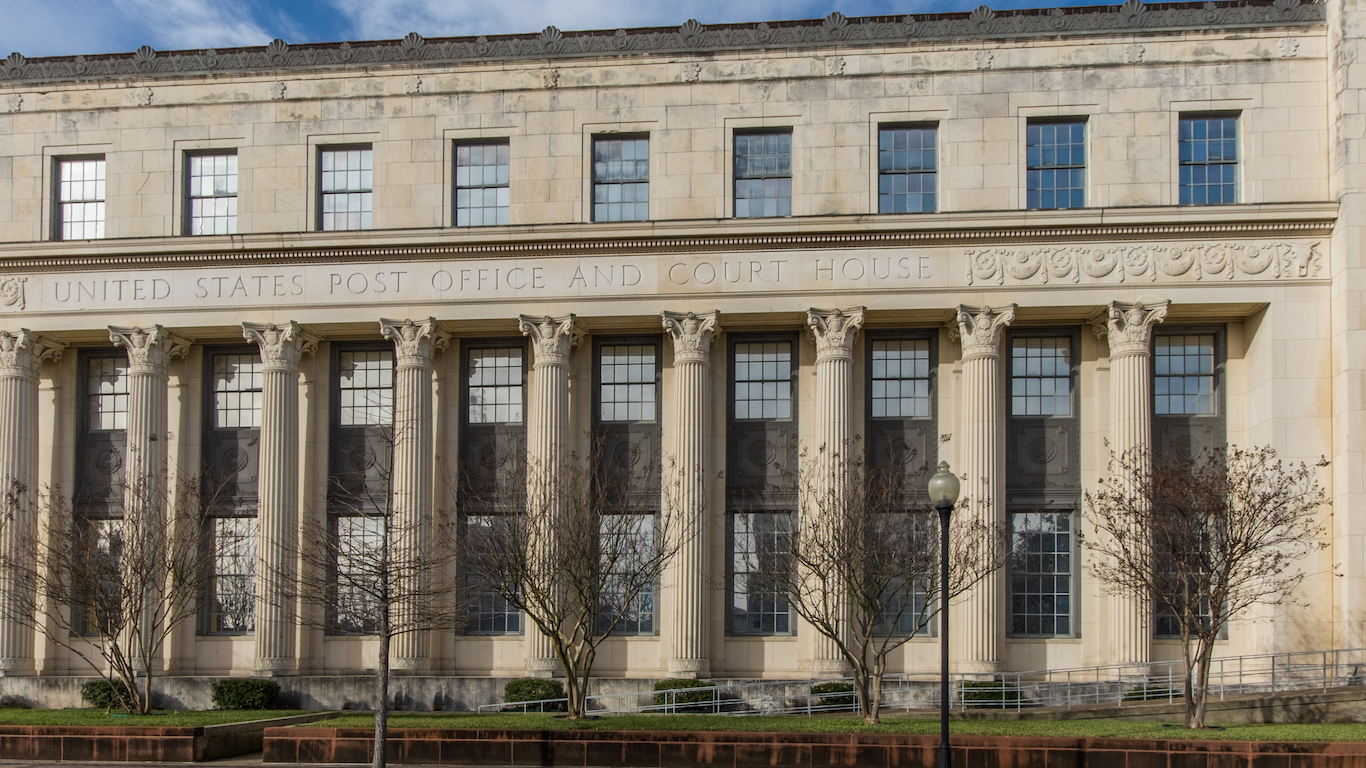
8. Beaumont-Port Arthur, TX
> Poverty rate: 15.7%
> Obesity rate: 35.1%
> Violent crimes per 100,000: 522.2
> 5-year pop. change: 1.2%
Neary 15% of those surveyed in the Beaumont-Port Arthur metro do not regularly experience happiness, nearly the largest such share in the country. Poor physical health can detract from mental well-being, and by many measures, large shares of residents in the Beaumont area are physically unhealthy. Obesity, diabetes, and high blood pressure are all far more common in the area than across the country as a whole. Making matters worse, some 22.5% of area residents lack health insurance, nearly the largest share in the country.
Poor economic conditions also likely detract from overall well-being in Beaumont-Port Arthur. The metro area is one of only a handful with an unemployment rate above 7%. Also, 23.4% of survey respondents cannot afford food, nearly the largest such share in the country.
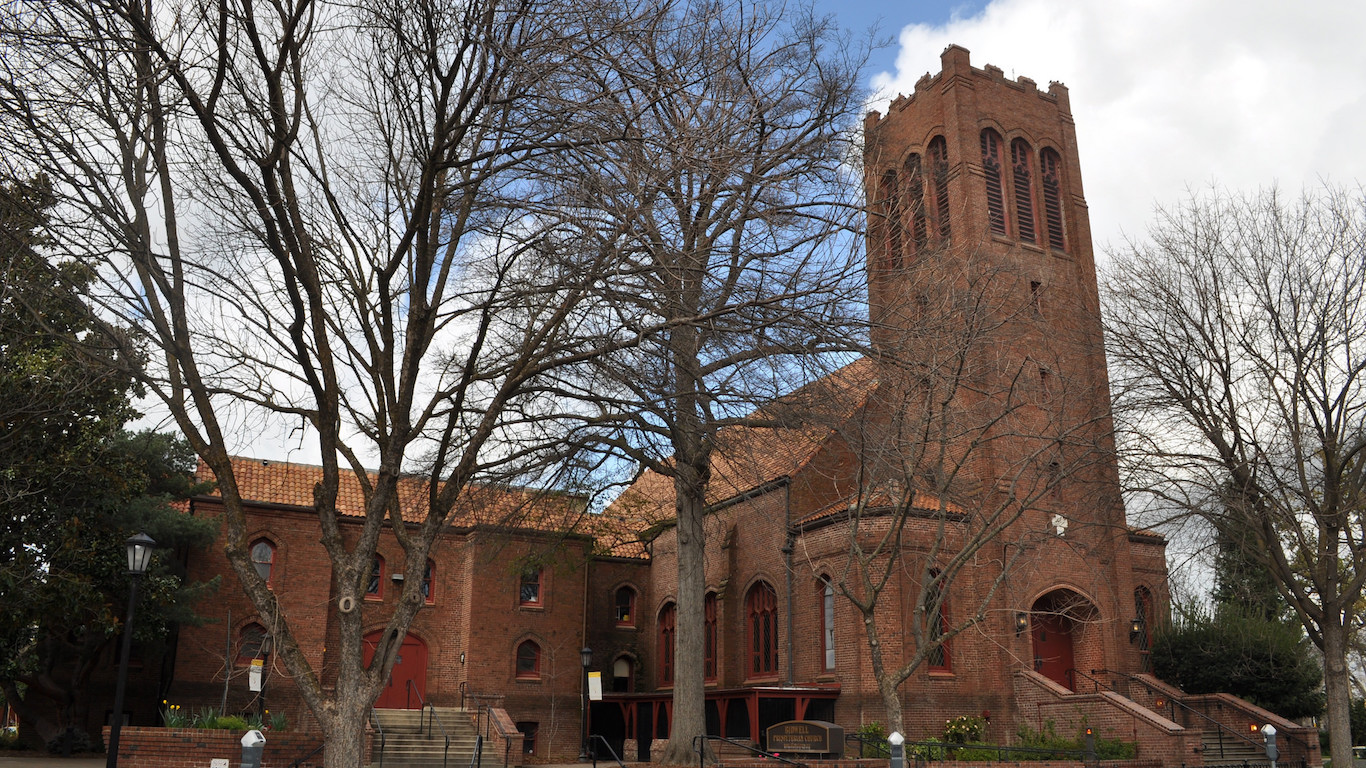
7. Chico, CA
> Poverty rate: 21.8%
> Obesity rate: 25.2%
> Violent crimes per 100,000: 345.6
> 5-year pop. change: 2.5%
Some 50.7% of survey respondents in the Chico, California metro area report dealing with stress, the largest share of any metro area in the country. For many, stress may be directly linked to financial struggles. Nearly 40% of survey respondents in the area report worrying about money in the previous seven days, one of the largest shares in the country. Chico residents tend to earn less than most Americans as the median household income in the area is only $45,644 a year, about $10,000 less than the national median.
Low self-reported well-being in Chico is also likely the result of poor physical health for many area residents. One-third of survey respondents in Chico have regular physical pain, the ninth highest share in the country.
[in-text-ad-2]

6. Flint, MI
> Poverty rate: 20.6%
> Obesity rate: 36.0%
> Violent crimes per 100,000: 581.4
> 5-year pop. change: -3.3%
News coverage of the Flint water crisis in recent years alerted the world to the poor judgment of the area’s public officials and the poor state of well-being of the city’s residents. Nearly 30% of surveyed area residents believe Flint is not the perfect city for them, the largest share of any metro area other than Fayetteville, North Carolina. While Flint’s water crisis was the result of several poor decisions at multiple levels of government, the public health emergency is symptomatic of the urban decay many poor Midwestern cities face. In recent decades, as the American auto industry declines, and General Motors reduced its facilities in the city, Flint’s economy has declined. Today, 20.6% of Flint residents live in poverty, and there are 581 violent crimes per 100,000 people — each among the highest rates of any metropolitan area. Nearly 18% residents report feeling unsafe, the fifth highest share nationwide.
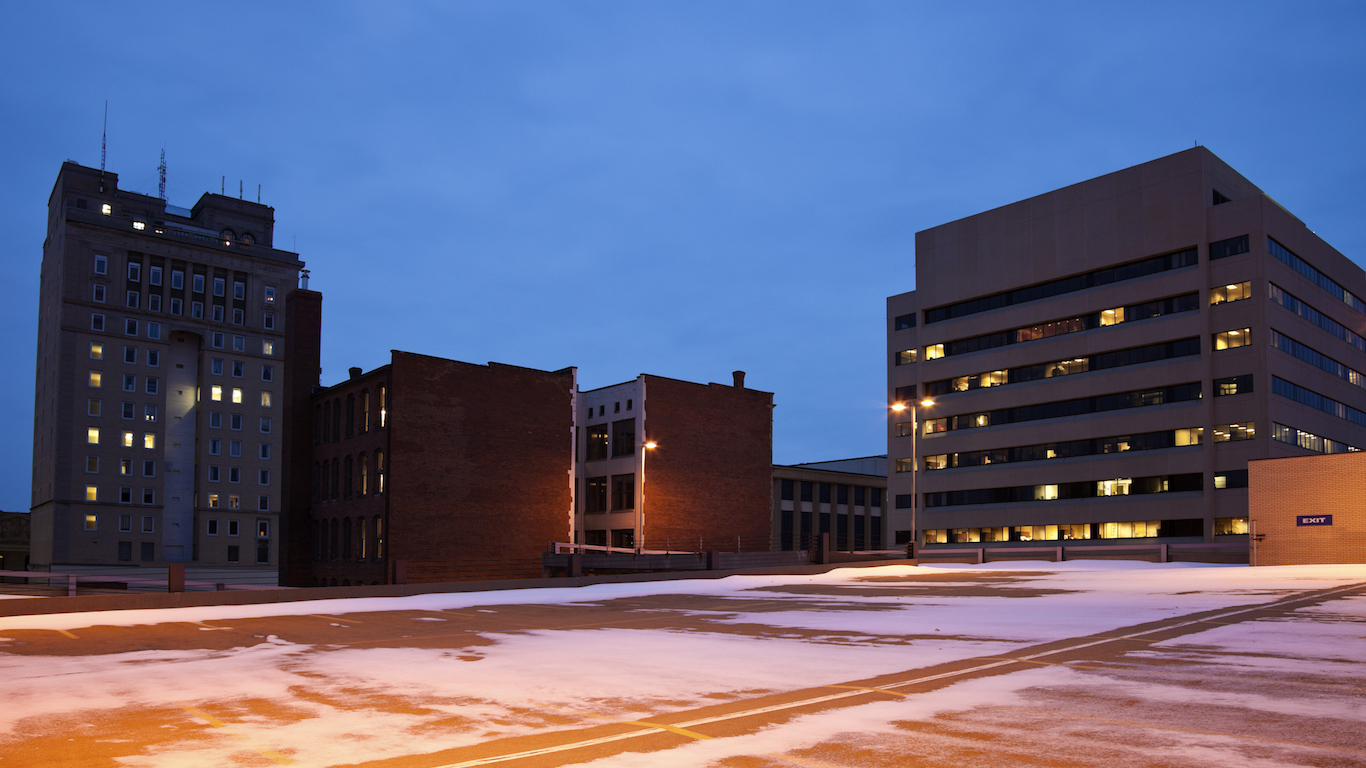
5. Canton-Massillon, OH
> Poverty rate: 13.2%
> Obesity rate: 31.1%
> Violent crimes per 100,000: 323.7
> 5-year pop. change: -0.3%
In the Canton-Massillon metro area, residents report a lesser sense of purpose in their daily lives than nearly any other metro area population. Only 73% say they enjoy what they do every day, one of the lowest shares nationwide. One reason for the low job satisfaction among Canton residents may be the area’s unhealthy job market. The economies of Canton and many other Rust Belt cities have suffered from the outsourcing of American steel production. The bygone industry may also be responsible for the significant air pollution in the area. The Centers for Disease Control and Prevention estimates that there are 14 micrograms of fine particulate matter per cubic meter of air in the Canton area, among the most of any metro area. Nearly 20% of residents believe Canton is not the perfect city for them, one of the higher shares nationwide.
[in-text-ad]
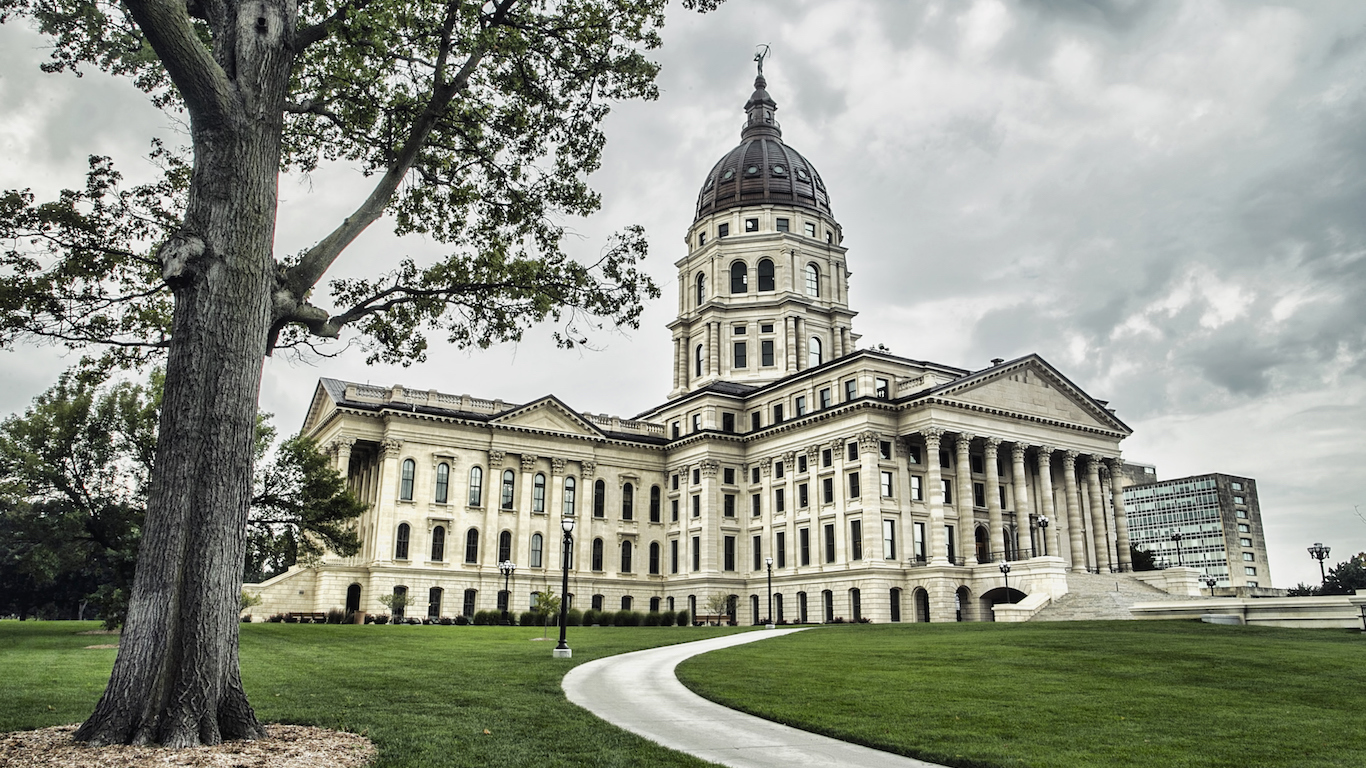
4. Topeka, KS
> Poverty rate: 13.3%
> Obesity rate: 32.6%
> Violent crimes per 100,000: 391.7
> 5-year pop. change: -0.2%
Residents of Topeka report a lower degree of physical well-being than those in nearly any other city. More than 31% of surveyed residents have had high cholesterol at some point in their lives, and 15% have had asthma, the fourth and eighth highest such shares of any metro. Additionally, only 56% believe their doctor would say they manage their health well, the smallest share of any city other than Fort Smith, Arkansas.
Nearly 28% of surveyed residents believe Topeka is not the best city for them, the fourth largest such share of any metro area. In recent years, some dissatisfied residents may have relocated. Compared to the U.S. population growth rate of 3.9% between 2010 and 2015, the number of Topeka residents fell by 0.2% over the same time period.

3. Huntington-Ashland, WV-KY-OH
> Poverty rate: 20.1%
> Obesity rate: 36.1%
> Violent crimes per 100,000: N/A
> 5-year pop. change: -1.0%
One of the largest determinants of happiness is physical well-being and residents of the Huntington-Ashland metro area are among the least healthy of any metro area nationwide. An estimated 33.3% of Huntington adults are not physically active, and 36.1% are obese, much larger shares than the 23.0% and 27.0% national inactivity and obesity rates. Approximately 39% of Huntington residents surveyed say they were prevented from doing their usual activities due to poor health, the largest share of any metro area. Poor physical health may be undermining mental health in the metro area. Some 29.1% of Huntington-Ashland residents have suffered from depression recently, the largest share of any city.
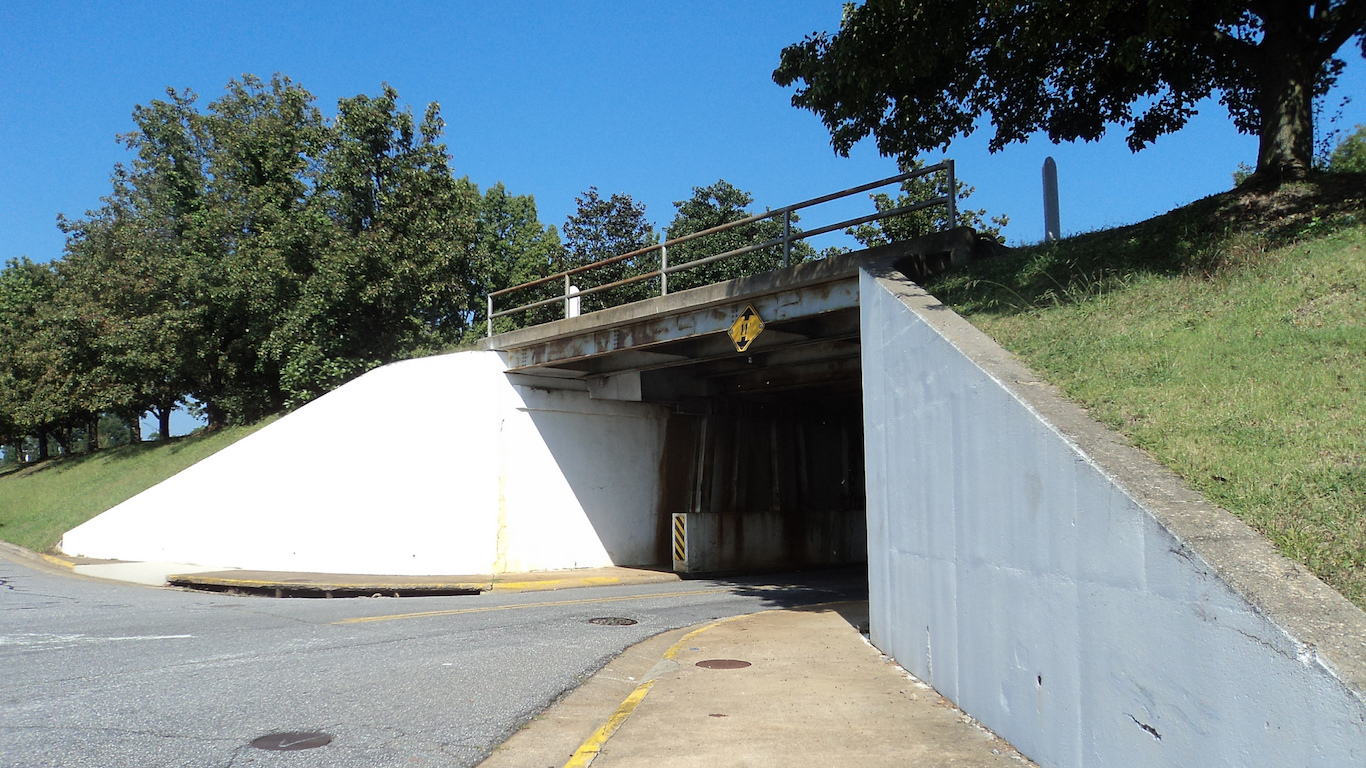
2. Hickory-Lenoir-Morganton, NC
> Poverty rate: 15.8%
> Obesity rate: 31.2%
> Violent crimes per 100,000: N/A
> 5-year pop. change: -0.7%
One of the largest setbacks to the well-being of Hickory-Lenoir-Morganton residents is likely their financial situation. The typical Hickory household earns just $40,380 a year, far less than the $55,775 a year the typical household nationwide earns. Nearly 46% of residents say they do not have enough money to pursue their wants and needs, the largest share of any metro area.
Some Hickory residents struggle to afford basic necessities. Approximately 20% of surveyed residents claim they do not have enough money for food, and 23% cannot afford health care, some of the largest shares of any city. Just 58% of Hickory residents have access to locations for physical activity such as parks or gyms, compared to 84% of Americans. Overall, only 44% of Hickory residents believe they are in near-perfect physical shape — the smallest share of any metro area.
[in-text-ad-2]

1. Fort Smith, AR-OK
> Poverty rate: 20.5%
> Obesity rate: 36.5%
> Violent crimes per 100,000: 446.0
> 5-year pop. change: -0.2%
Compared with nearly 200 U.S. metro areas, Fort Smith residents report the lowest well-being. Residents are considerably more likely than people nationwide to earn low incomes and report financial distress as well as the poor health outcomes that are often associated with financial hardship. The typical household earns $41,040 annually, and 20.5% of people live in poverty, versus the national median income of $55,775 and poverty rate of 14.7%. Nearly 44% of survey respondents in the area say they worry about money, and 28% report not having enough money to buy food, each the highest such percentages of all metro areas reviewed.
Physical and mental health are major determinants of well-being. In Fort Smith, the proportions of people who report high blood pressure (43.5%), say that poor health hinders regular activity (36.4%), and who have experienced depression (28.1%) are each among the top five such shares nationwide.
Are you ready for retirement? Planning for retirement can be overwhelming, that’s why it could be a good idea to speak to a fiduciary financial advisor about your goals today.
Start by taking this retirement quiz right here from SmartAsset that will match you with up to 3 financial advisors that serve your area and beyond in 5 minutes. Smart Asset is now matching over 50,000 people a month.
Click here now to get started.
Thank you for reading! Have some feedback for us?
Contact the 24/7 Wall St. editorial team.